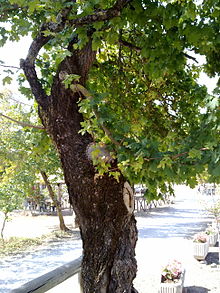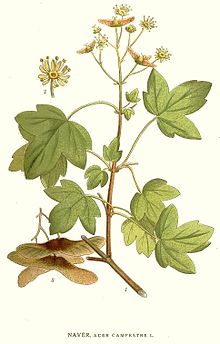| Acer campestre | |
|---|---|

| |
| Scientific classification | |
| Kingdom: | Plantae |
| Clade: | Tracheophytes |
| Clade: | Angiosperms |
| Clade: | Eudicots |
| Clade: | Rosids |
| Order: | Sapindales |
| Family: | Sapindaceae |
| Genus: | Acer |
| Section: | Acer sect. Platanoidea |
| Species: | A. campestre |
| Binomial name | |
| Acer campestre L. | |

| |
| Distribution | |
| Synonyms | |
List
| |

Acer campestre, known as the field maple, is a flowering plant species in the family Sapindaceae. It is native to much of continental Europe, Britain, southwest Asia from Turkey to the Caucasus, and north Africa in the Atlas Mountains. It has been widely planted, and is introduced outside its native range in Europe and areas of USA and Western Australia with suitable climate.
Description
It is a deciduous tree reaching 15–25 m (49–82 ft) tall, with a trunk up to 1 m (3 ft 3 in) in diameter, with finely fissured, often somewhat corky bark. The shoots are brown, with dark brown winter buds. The leaves are in opposite pairs, 5–16 cm (2.0–6.3 in) long (including the 3–9 cm (1.2–3.5 in) petiole) and 5–10 cm (2.0–3.9 in) broad, with five blunt, rounded lobes with a smooth margin. Usually monoecious, the flowers are produced in spring at the same time as the leaves open, yellow-green, in erect clusters 4–6 cm (1.6–2.4 in) across, and are insect-pollinated. The fruit is a samara with two winged achenes aligned at 180°, each achene is 8–10 mm (0.31–0.39 in) wide, flat, with a 2 cm (0.79 in) wing.
The two varieties, not accepted as distinct by all authorities, are:
- Acer campestre var. campestre - downy fruit
- Acer campestre var. leiocarpum (Opiz) Wallr. (syn. A. campestre subsp. leiocarpum) - hairless fruit
The closely related Acer miyabei replaces it in eastern Asia.
Distribution
The native range of field maple includes much of Europe, including Denmark, Poland and Belarus, England north to southern Scotland (where it is the only native maple), southwest Asia from Turkey to the Caucasus, and north Africa in the Atlas Mountains. In many areas, the original native range is obscured by widespread planting and introductions. In North America it is known as hedge maple and in Australia, it is sometimes called common maple. In Nottinghamshire, England it was known locally as dog oak.
Ecology
Field maple is an intermediate species in the ecological succession of disturbed areas; it typically is not among the first trees to colonise a freshly disturbed area, but instead seeds in under the existing vegetation. It is very shade-tolerant during the initial stages of its life, but it has higher light requirements during its seed-bearing years. It exhibits rapid growth initially, but is eventually overtaken and replaced by other trees as the forest matures. It is most commonly found on neutral to alkaline soils, but more rarely on acidic soil.
Diseases include a leaf spot fungus Didymosporina aceris, a mildew Uncinula bicornis, a canker Nectria galligena, and verticillium wilt Verticillium alboatrum. The leaves are also sometimes damaged by gall mites in the genus Aceria, and the aphid Periphyllus villosus.
Cultivation
The field maple is widely grown as an ornamental tree in parks and large gardens. The wood is white, hard and strong, and used for furniture, flooring, wood turning and musical instruments, though the small size of the tree and its relatively slow growth make it an unimportant wood. It has an OPALS rating of 7.
It is locally naturalised in parts of the United States and more rarely in New Zealand. The hybrid maple Acer × zoeschense has A. campestre as one of its parents.
The tree has gained the Royal Horticultural Society's Award of Garden Merit.
Cultivars
Over 30 cultivars of Acer campestre are known, selected for their foliage or habit, or both; several have been lost to cultivation.
- 'Carnival'
- 'Commodore'
- 'Compactum'
- 'Eastleigh Weeping'
- 'Elegant'
- 'Elsrijk'
- 'Evenly Red'
- 'Fastigiatum'
- 'Green Weeping'
- 'Leprechaun'
- 'Lienco'
- 'Marjolein'
- 'Nanum'
- 'Pendulum'
- 'Postelense'
- 'Pulverulentum'
- 'Punctatissimum'
- 'Puncticulatum'
- 'Queen Elisabeth'
- 'Red Shine'
- 'Royal Ruby'
- 'Ruby Glow'
- 'Schwerinii'
- 'Senator'
- 'Silver Celebration'
- 'Silver Dawn'
- 'Streetwise'
- 'Tauricum'
- 'Tomentosum'
- 'William Caldwell'
- 'Zorgvlied'
Bonsai
Acer campestre (and the similar A. monspessulanum) are popular among bonsai enthusiasts. The dwarf cultivar 'Microphyllum' is especially useful in this regard. A. campestre bonsai have an appearance distinct from those selected from some other maples such as A. palmatum with more frilly, translucent, leaves. The shrubby habit and smallish leaves of A. campestre respond well to techniques encouraging ramification and leaf reduction.
Gallery
-
 Field maple leaf
Field maple leaf
-
 Leaves and flowers
Leaves and flowers
-
 Field maple, Germany
Field maple, Germany
-
 Leaves
Leaves
-
 Foliage in spring
Foliage in spring
-
 Field maple, Hesse, Germany
Field maple, Hesse, Germany
-
 Field maple leaf
Field maple leaf
-
 Fruits
Fruits
-
 Field maple
Field maple
-
Field maple flowers
-
Field maple in autumn, France
-
 Field maple, Germany
Field maple, Germany
-
 Field maple, Spain
Field maple, Spain
-
 Leaves and inflorescence
Leaves and inflorescence
-
Leaves and fruits
-
Trunk
-
 Maple field tree, Weinsberg
Maple field tree, Weinsberg
-
 Leaf
Leaf
References
- "Acer campestre L." Plants of the World Online. Board of Trustees of the Royal Botanic Gardens, Kew. 2017. Retrieved 31 July 2020.
- BSBI List 2007 (xls). Botanical Society of Britain and Ireland. Archived from the original (xls) on 2015-06-26. Retrieved 2021-03-03.
- ^ Rushforth, K. (1999). Trees of Britain and Europe. Collins ISBN 0-00-220013-9.
- ^ Mitchell, A. F. (1974). A Field Guide to the Trees of Britain and Northern Europe. Collins ISBN 0-00-212035-6
- ^ Euro+Med Plantbase Project: Acer campestre Archived 2007-09-28 at the Wayback Machine
- "Acer campestre". Flora Europaea. Retrieved August 29, 2007.
- Flora of NW Europe: Acer campestre
- Den virtuella floran: Acer campestre distribution map
- ^ Nagy, L.; Ducci, F. (2004). "Acer campestre - Field maple" (PDF). EUFORGEN Technical Guidelines for Genetic Conservation and Use: 6 p. Archived from the original (PDF) on 2016-10-19.
- "Online atlas of the British and Irish flora, Acer campestre (Field maple)". Biological Records Centre and Botanical Society of Britain and Ireland.
- ^ "Acer campestre". USDA Plants Profile. Retrieved August 29, 2007.
- "Acer campestre". Ohio State University. Archived from the original on September 1, 2006. Retrieved August 29, 2007.
- Department of Agriculture, Western Australia: Pests and Diseases Image Library Archived 2008-08-19 at the Wayback Machine
- Wright, Joseph. The English dialect dictionary. Vol. 6. London: Oxford University Press. p. 109.
- "Field maple images and diseases". Archived from the original on 2007-09-28. Retrieved 2007-08-29.
- "Field maple_Woodland Trust". Archived from the original on 2010-09-13. Retrieved 2010-08-24.
- Ogren, Thomas Leo (2000). Allergy-Free Gardening. Berkeley, California: Ten Speed Press. p. 30. ISBN 1580081665.
- Trans. and Proc. Roy. Soc. New Zealand 36: 203-225 Plants naturalised in the County of Ashburton
- "Acer campestre". www.rhs.org. Royal Horticultural Society. Retrieved 27 February 2020.
- "AGM Plants - Ornamental" (PDF). www.rhs.org. Royal Horticultural Society. November 2018. p. 1. Retrieved 27 February 2020.
- van Gelderen, C.J.; van Gelderen, D.M. (1999). Maples for Gardens: A Color Encyclopedia.
- "A. campestre". Bonsai Club International. Archived from the original on November 11, 2006. Retrieved November 26, 2006.
- D'Cruz, Mark. "Ma-Ke Bonsai Care Guide for Acer campestre". Ma-Ke Bonsai. Archived from the original on March 15, 2012. Retrieved April 15, 2011.
Further reading
- Chybicki, Igor J.; Waldon-Rudzionek, Barbara; Meyza, Katarzyna (December 2014). "Population at the edge: increased divergence but not inbreeding towards northern range limit in Acer campestre". Tree Genetics & Genomes. 10 (6): 1739–1753. doi:10.1007/s11295-014-0793-2.
| Taxon identifiers | |
|---|---|
| Acer campestre |
|